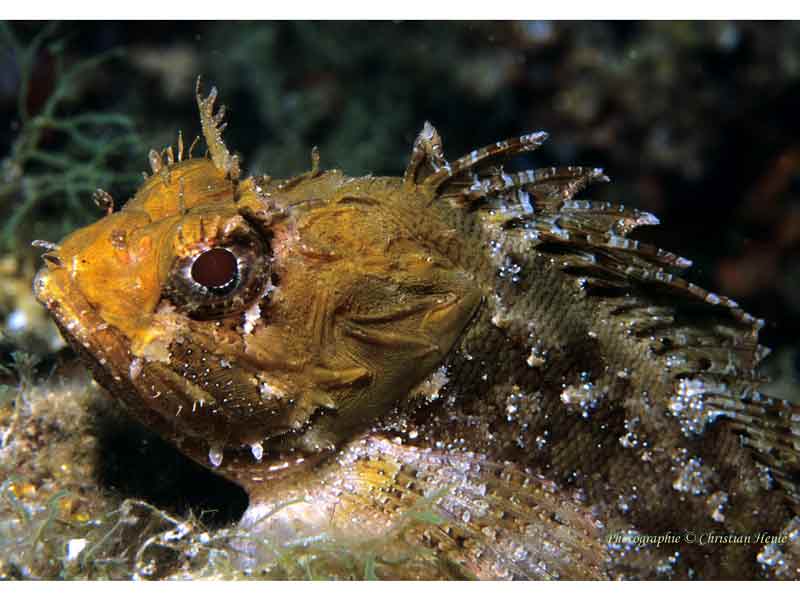Black scorpionfish (Scorpaena porcus)
Distribution data supplied by the Ocean Biodiversity Information System (OBIS). To interrogate UK data visit the NBN Atlas.Map Help
| Researched by | Al Reeve | Refereed by | Admin |
| Authority | Linnaeus, 1758 | ||
| Other common names | - | Synonyms | - |
Summary
Description
Recorded distribution in Britain and Ireland
The south coast of England represents the northern limit of Scorpaena porcus. It is an infrequent visitor to the coastal waters off the south coast and is unlikely to be seen very often.Global distribution
-Habitat
Scorpaena porcus is a benthic species found from the littoral zone down to a depth of around 800 m. Usually seen motionless and solitary amongst rocks and algae on the seabed.Depth range
-Identifying features
- Brown or orangy brown in colour and growing up to 37 cm in length.
- Three dark vertical bars on the caudal fin.
- Numerous well developed skin appendages and spines.
- Large fleshy appendage behind eye.
- Light spot on skin between the eigth and ninth dorsal spine.
Additional information
Scorpaena porcus is similar to Scorpaena scrofa in morphology and distribution. However, Scorpaena scrofa occurs in water between 20 -110 m, is a brighter orange colour and has less well developed spines behind the operculum. Scorpaena scrofa also grows to a length of 51 cm.Spines of the dorsal, pelvic and anal fins of black scorpionfish have venom glands at their bases. The venomous spines cause an intense pain and throbbing to people stung by it. Treatment is to immerse the affected area in water heated to tolerance level and to disinfect the afflicted area.
This species is also known as the small-scaled scorpionfish (D. Herdson, pers. comm.)Listed by
- none -
Bibliography
FishBase, 2000. FishBase. A global information system on fishes. [On-line] http://www.fishbase.org, 2001-05-03
Howson, C.M. & Picton, B.E., 1997. The species directory of the marine fauna and flora of the British Isles and surrounding seas. Belfast: Ulster Museum. [Ulster Museum publication, no. 276.]
JNCC (Joint Nature Conservation Committee), 1999. Marine Environment Resource Mapping And Information Database (MERMAID): Marine Nature Conservation Review Survey Database. [on-line] http://www.jncc.gov.uk/mermaid
MarLIN (Marine Life Information Network), 2005. SEArchable BEnthic Data (SEABED) Map [on-line]. Data Access Sub-programme, Marine Life Information Network for Britian and Ireland http://www.marlin.ac.uk,
Wheeler, A., 1969. The fishes of the British Isles and north-west Europe. London: Macmillan.
Whitehead, P.J.P., Bauchot, M.-L., Hureau, J.-C., Nielson, J. & Tortonese, E. 1986. Fishes of the North-eastern Atlantic and the Mediterranean. Vol. I, II & III. Paris: United Nations Educational, Scientific and Cultural Organisation (UNESCO).
Datasets
National Trust, 2017. National Trust Species Records. Occurrence dataset: https://doi.org/10.15468/opc6g1 accessed via GBIF.org on 2018-10-01.
NBN (National Biodiversity Network) Atlas. Available from: https://www.nbnatlas.org.
OBIS (Ocean Biodiversity Information System), 2025. Global map of species distribution using gridded data. Available from: Ocean Biogeographic Information System. www.iobis.org. Accessed: 2025-08-08
Citation
This review can be cited as:
Last Updated: 02/01/2007



